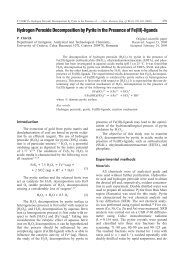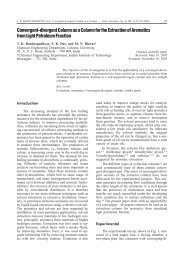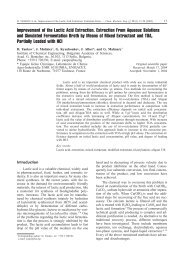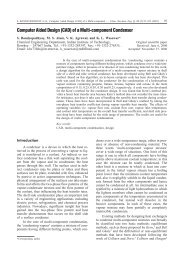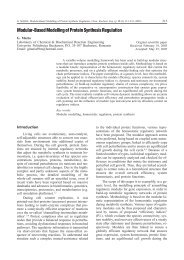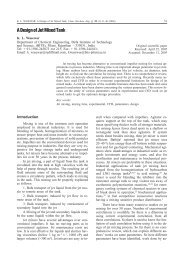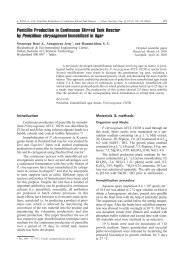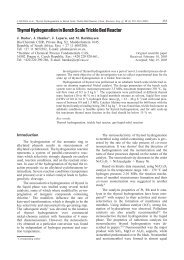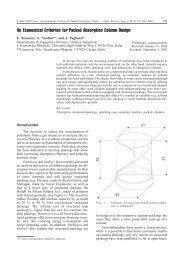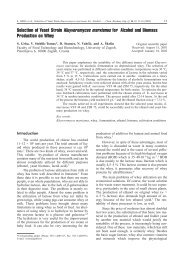54 S. BHARGAV et al., <strong>Solid</strong>-state <strong>Fermentation</strong>: <strong>An</strong> <strong>Overview</strong>, Chem. Biochem. Eng. Q. 22 (1) 49–70 (2008)and unloading of the reactor. The aim of Zymotis isto minimize vertical temperature gradients andmaximize the heat transfer through cooling water. 22In conclusion, most researchers for bioreactordevelopment have used mathematical modeling atmicroscopic scale using simple logistic kinetics.Logistic equations are simpler than complex partialdifferential equations and represent whole datawithout complexity. Modeling at microscopic leveldirectly affects heat and mass transfer in bioreactors,which affects scale-up of the bioprocess.Continuous operating bioreactors based on agro-industrialresidues are to be modeled. These bioreactorsshould have arrangements for substrate addition,water replacement and air inlet. However,validation of artificial results at smaller scale is necessaryin reality at a larger scale for success of themathematical modeling.BioreactorsIn fermentation processes, bioreactor systemsprovide the environment for growth, cultivation ofmicrobes. However, some of the factors affectingthe growth of the product in SSF bioreactors aretemperature, humidity of substrate bed, type of substrateused, size of the bioreactor, aeration, coolingrate, height of bed and fungal morphology. Whencompared to submerged fermentation, SSF is carriedout in simple bioreactor systems; SSF bioreactorsare fitted with a humidifier and with orwithout an agitator unit. Poor thermal conductivityof the substrate bed presents a great challenge tobioreactor design, but composition, particle size,porosity and water-holding capacity of the substrateused also affects the bioreactor.Various researchers have classified the SSFbioreactors broadly 20,50,52,53 but most bioreactors canbe distinguished by a factor whether they are usedat small scale and large scale.Small-scale bioreactors<strong>Solid</strong>-state fermentation at laboratory scale iscarried out in Petri dishes, jars, wide mouthed Erlenmeyerflasks, roux bottles, and roller bottles. Thesesystems are simple and experiments are carriedout easily. 53 There are several forms of small-scalebioreactors such as column bioreactors. MaurisRaimbault and J. C. Germon in ORSTOM (InstitutFrançais de Recherche Scientifique pour le Developpmenten Cooperation, France) laboratory ofsoil microbiology designed it in 1980, for growingAspergillus niger on cassava meal in solid-state.Column bioreactors consist of small columns (diameter:D = 22 mm, height: H = 210 mm) whichcan hold 20 g of pre-inoculated solid material. Approximately24 such columns were put together inthermo-regulated water baths and water-saturatedair was passed through each column at a flow rateof Q = 4–6 Lh –1 . Column bioreactors are usefulfor optimization of the medium, and constitute animportant part of research. However, difficulty liesin obtaining the product and poor heat removal.Pandey et al. 54 determined the performance of thecolumn bioreactor for glucoamylase production.Columns of different diameters were used and arrangedwith different substrate bed heights of h =4.5, 9, 18, 22.5 cm. Enhancement in substrate bedheight increased the enzyme synthesis. The columnwith 18 cm of bed height produced maximum enzymein 48 h with an aeration rate of Q a = 1 to 1.5LL –1 min –1 . However, with further increase in bedheight, enzyme synthesis decreased. The decreasemay be due to the reduced aeration rate with increasedheight of the substrate bed.A few years later the INRA (Institut Nationalde la Recherche Agronomique, Dijon, France) teamdeveloped a reactor with one liter working volumefitted with a relative humidity probe, a cooling coilin heating circuit, and a cover for the reactor vessel.These reactors were filled with pre-inoculated solidmaterial, and a computer controlled all parametersof the reactor. Sampling for analysis was easier inINRA bioreactors. This was the advantage overORSTOM bioreactors. The automatic control ofrelative humidity and temperature makes these reactorsuseful in scale-up studies.Apart from non-agitated column reactors, thereare bioreactor systems with agitator systems such asperforated-drum reactor and horizontal paddlemixer (with or without water jacket). Drum bioreactorsare designed to mix the solid substrate byrotating horizontal rotation vessels (which are withor without baffles). The rotation or agitation createstumbling in the matrix of the solid medium by minimizingthe heat produced. However, mixing ofinoculum with substrate is uniform in drum bioreactorsbut fungi morphology is readily damagedby high shear, stress is not used in such bioreactors.However, an intermittent mixing strategy is involvedin these bioreactors, which gives balancebetween positive effects of increasing temperatureon deleterious effects on fungal hyphae. 52,55 A paddlemixer was developed by Wageningen Universityof Agriculture. It consists of a number ofblades making mixing more efficient than rotatingdrum. 52Various advancements have been made throughrotating drum bioreactors. Kalogeris et al. have developeda laboratory scale intermittent agitation rotatingdrum type bioreactor for SSF of thermophillicorganisms. The main parts of the apparatusare: perforated (pore size, S =1mm 2 ) cylindrical
S. BHARGAV et al., <strong>Solid</strong>-state <strong>Fermentation</strong>: <strong>An</strong> <strong>Overview</strong>, Chem. Biochem. Eng. Q. 22 (1) 49–70 (2008) 55drum (diameter, D = 0.15 m; length, L = 0.59m; capacity,V = 10 L), vessel with water jackets, motorconnected to controller, heat exchanger, condenserat air outlet, and humidifier. 56 Kalogeris et al. determinedthe efficiency of the bioreactor by producinghemicellulases and cellulases with a thermophillicfungus, Thermoascus aurantiacus, usingwheat straw as substrate. He examined the effectsof temperature, moisture and aeration. Among thevarious kinetic models tested, Le Duy model describedthe relationship between T. auranticusgrowth and enzyme production. However, increasein aeration rate and high moisture levels favored theenzyme and enzyme production. The bioreactor canbe used for production of hydrolases from thermophillicorganisms due to their superior thermo-stability,optimum activity at elevated temperatures,and high rates of substrate hydrolysis. 57A Zymotis packed bed reactor was developed atlaboratory scale by the ORSTOM team. Zymotisbioreactors are a modification of packed bed bioreactorswith internal plates in which cold water circulatesat an optimum temperature. Variation in optimumtemperature retards the initial growth of theculture used. In packed bed bioreactor, large axialtemperature gradients arise leading to poor microbialgrowth at the end of the base near the outlet,with an increase in vertical temperature gradients. 22<strong>An</strong>other bioreactor (Growtek) was developedby a team of scientists at IIT (Indian Institute ofTechnology) Kharagpur, India, for plant tissue culturebut later it was used for solid-state fermentation.This bioreactor has a cylindrical vessel (widthD = 11.3 cm, height H = 16 cm) with a spout at thebase, inclined at an angle of = 15° having a diameterof d = 2.6 cm and length of l = 8.5 cm. Bothvessel and spout have lids. A float of area A =72cm 2 is provided inside the vessel, which consists ofa perforated base. <strong>Fermentation</strong> of solid substrate iscarried out on a float to which the seed culture isadded, while liquid salt solution is kept below thefloat. <strong>An</strong> advantage of the Growtek bioreactor isthat the inoculated solid comes into direct contactwith the liquid medium. The products formed duringthe fermentation process leach in liquid medium.This type of bioreactor was used for productionof gallic acid from tannin-rich solid material. 37Ahamad et al. used a Growtek bioreactor for productionof mevastatin by Penicillium citrinum fromwheat bran. 58Large scale bioreactorsThe successful operation of large-scale bioreactorsdepends on design features obtained aftermathematical modeling, susceptibility of the substrateand fungal morphology to increase in temperature,effect of particle size and voids betweenthem, quantity of the substrate used, and height ofthe substrate bed. There are several forms oflarge-scale bioreactors used in SSF.Koji types of bioreactors are the simplest andwithout forced aeration. These types of bioreactorsare also known as tray bioreactors. The trays aremade of wood, plastic, metal. It is not necessarythat trays should be perforated. Trays are arrangedone above the other with suitable gaps betweenthem and placed in climatic controlled chamber undercirculating air, which maintain uniform temperature.<strong>An</strong> advantage of this technology is that by increasingthe number of trays, the scale-up is easier.However, the requirement of sterility, large spaceand labor makes the process difficult. Rodriguez etal. reported the tray bioreactor to be appropriate forproducing laccase by T. versicolor in solid-stateconditions operating with lignocellulosic supportsbesides their several disadvantages. 59 Rodriguez etal. also proved superiority of grape seeds over nylonsponge supports using tray configuration duringlaccase production (with Trametes hirsuta underSSF conditions). 60 A Shallow tray fermentor wasused at laboratory scale for cellulase productionwith Trichoderma reesei ZU02 strain on corncobresidues. 61However, BIOCON India has used this technologyfor large-scale production of immuno-suppressants.They have simplified problems of sterilityby keeping the trays in HEPA (High EfficiencyParticulate Air) filtered air, using automated machinesfor layering the substrate in trays.Packed bed bioreactors are modifications oflaboratory-scale column reactors. A sieve present atthe bottom is used for holding the substrate. Passingforced air through the static bed provides aeration.Heat produced during fermentation within the substratebed is a major limitation of these reactors.However, reduction in water content within the substratebed increases its hardening. This decreasesfungal penetration within the bed, causing reductionin product formation. Hence, it is advantageous touse thermo-stable fungus for producing a thermo--stable product (especially enzymes) in packed bedreactors. Heat produced in the packed column canbe reduced by increasing the moisture of air insideit, which is achieved by passing cold saturated airor using heat exchangers as in Zymotis. Pressuredrop is an important feature of the packed reactor.High-pressure drop reduces airflow from the substratefavoring channeling within the bed. 53 Thechanneling decreases optimum temperature requiredfor growth of organisms in the substrate bed.Some large-scale bioreactors like PLAFRACTOR 62use heat exchangers for controlling temperatureduring fermentation. However, enhancing agitation
- Page 1 and 2: S. BHARGAV et al., Solid-state Ferm
- Page 3 and 4: S. BHARGAV et al., Solid-state Ferm
- Page 8 and 9: 56 S. BHARGAV et al., Solid-state F
- Page 10 and 11: 58 S. BHARGAV et al., Solid-state F
- Page 12 and 13: 60 S. BHARGAV et al., Solid-state F
- Page 14 and 15: 62 S. BHARGAV et al., Solid-state F
- Page 16 and 17: 64 S. BHARGAV et al., Solid-state F
- Page 18 and 19: 66 S. BHARGAV et al., Solid-state F
- Page 20 and 21: 68 S. BHARGAV et al., Solid-state F
- Page 22: 70 S. BHARGAV et al., Solid-state F



